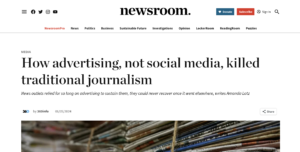By Tony Silber
The news-media industry has been in turmoil for years—that’s indisputable. After nearly two decades of media brands shutting down, layoffs of thousands of news professionals, the creation of “news deserts” across wide swaths of America, the industry is in crisis.
There’s now effectively no news media at all in some parts of the country. That means there’s no reporting on school boards, no news of environmental threats, no check on governments at all, not to mention no reporting on all the other civic affairs we all depend on news media for—stores opening and closing, sports activities, events and so much more.
Most of the time, the blame for journalism’s decline is assigned to search and social media. The shift from print to digital media, and the migration of attention away from traditional news sources, undermined the journalism business model.
In some ways, news organizations have only themselves to blame. Since the emergence of the internet back in the late 1990s, they bought into the notion that information should spread freely online—including the news content they created at great cost to themselves. Online would produce links, attention, eyeballs, traffic, which would then convert into new subscriptions and more advertising.
That was the theory, anyway. The print entity—usually a newspaper, but also magazines—would pay the bills through subscriptions and advertising.
It didn’t work out that way.
Social media emerged as a news-distribution platform, joining search. Both serve as channels for readers to find information and for advertisers to find customers. Print news businesses declined to the point where they weren’t really sustainable as businesses in many instances.
Which leads to a widely assumed premise: Social media and search are killing the journalism business.
 That may be, according to an article I read earlier this month from the New Zealand current-events site Newsroom, which covers politics, business, and climate change, among other topics. But in the article, author Amanda Lotz argues that social media didn’t kill journalism. At least not in the ways we often assume. The shift in reader attention from newspapers and magazines to social and search isn’t killing journalism. The use of search and social as a news-distribution channel isn’t killing journalism. Advertising is.
That may be, according to an article I read earlier this month from the New Zealand current-events site Newsroom, which covers politics, business, and climate change, among other topics. But in the article, author Amanda Lotz argues that social media didn’t kill journalism. At least not in the ways we often assume. The shift in reader attention from newspapers and magazines to social and search isn’t killing journalism. The use of search and social as a news-distribution channel isn’t killing journalism. Advertising is.
In other words, the argument goes, marketing budgets aimed at newspapers and that used to be spent on print ads and direct mail migrated to more targeted efforts based on a deeper understanding of buyer intent. “The development of more effective and efficient advertising tools is what killed traditional newspaper operations, not the circulation of news on social media,” Lotz writes.
I’d argue that traditional media—print and digital together—are essential for advertising messaging. This may not apply in the same way for news-oriented media, for journalism. But top-of-the-funnel awareness campaigns, through to purchase, certainly still work.
Anyway, Lotz continues, the truth is that social and search are not better than print and digital media brands at producing and distributing news. In fact, they were never in that business to begin with.
Now, Lotz concludes, it’s time to redouble the years-long efforts to find a new business model to sustain journalism. “The challenge remains the same: find ways to fund the journalism that democratic societies need to stay healthy offering people what they need to go about daily life and participate in their community,” she writes.
